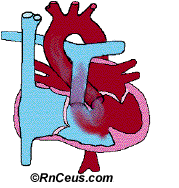 VSD is a type of "acyanotic" heart defect, so called
because arterial (oxygenated) blood is moved or shunted to the venous (de-oxygenated)
system. This is sometimes referred to as a "left-to-right" shunt.
VSD is a type of "acyanotic" heart defect, so called
because arterial (oxygenated) blood is moved or shunted to the venous (de-oxygenated)
system. This is sometimes referred to as a "left-to-right" shunt.
 VSD is a type of "acyanotic" heart defect, so called
because arterial (oxygenated) blood is moved or shunted to the venous (de-oxygenated)
system. This is sometimes referred to as a "left-to-right" shunt.
VSD is a type of "acyanotic" heart defect, so called
because arterial (oxygenated) blood is moved or shunted to the venous (de-oxygenated)
system. This is sometimes referred to as a "left-to-right" shunt.
Conversely, cyanotic defects involve the shunting of de-oxygenated blood to the arterial system. When venous blood is shunted to the arterial system, the patient presents with a characteristic blue or "cyanotic" coloration.
In the heart with VSD, an opening is present in the septum between the right and left ventricles. When the heart with VSD contracts, oxygenated (red) blood follows the path of least resistance across the septal defect, through the pulmonic valve and into the lungs.
This happens primarily because the left ventricle's thick muscular walls contract with more force than the right ventricle. Also, the lung vessels may compensate for the additional flow by expanding, which reduces pulmonary vascular resistance. When the lung vessels are forced to accept the additional blood volume ejected through the defect, they can become overloaded and congested. Prolonged inefficient pumping, and subsequent overload of the right side of the heart and lungs predisposes the patient to congestive heart failure.
Instant
Feedback:
VSD is considered to be what type
of defect?
© RnCeus.com